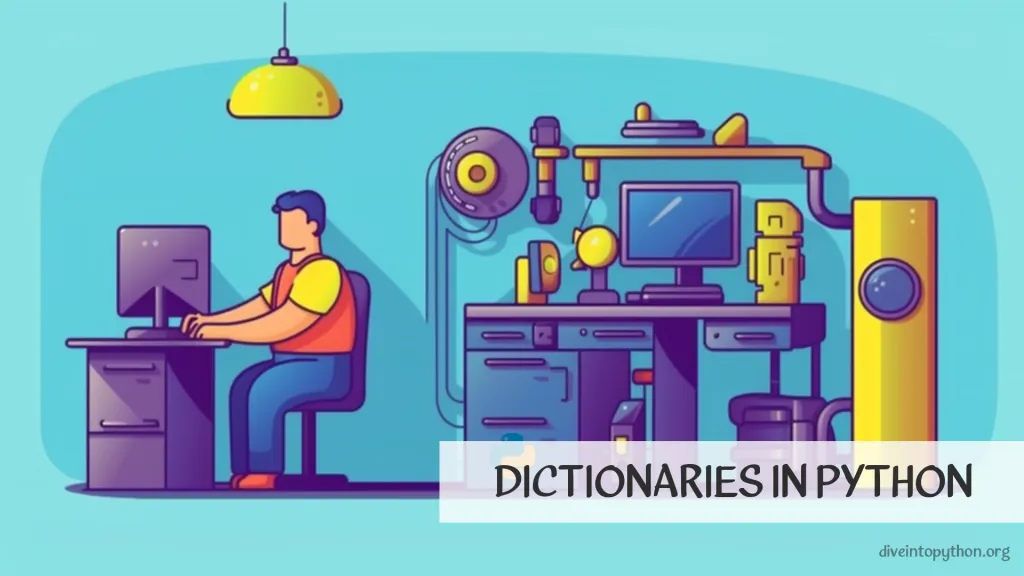
Python provides several built-in collection types to store and manipulate data. Some of the commonly used collection types in Python are:
- Lists
- Tuples
- Sets
- Dictionaries
- Arrays
- Deques
There are also other less commonly used collection types in Python, such as namedtuples, default dictionaries, and heaps, which are specialized versions of the basic collection types listed above.
Definition of Dictionary
A dictionary in Python is a collection of key-value pairs, where each key is associated with a value. It is an unordered data structure, and each key in the dictionary must be unique.
Here is a dictionary example in Python:
# Define a dictionary with key-value pairs
student = {
"name": "Alice",
"id": 12345,
"courses": ["Math", "Physics", "Chemistry"],
"grades": {"Math": 90, "Physics": 85, "Chemistry": 95}
}
How to Create a Dictionary in Python
Let's take a look at how to create or initialize a dictionary in Python. You can do it using curly braces {} or by using the dict() function. Here are some examples:
- Using curly braces:
# Create an empty dictionary
empty_dict = {}
# Create a dictionary with key-value pairs
my_dict = {'name': 'John', 'age': 30, 'city': 'New York'}
# Create a dictionary with mixed data types
mixed_dict = {'name': 'John', 'age': 30, 'scores': [85, 90, 95]}
- Using the
dict()function:
# Create an empty dictionary
empty_dict = dict()
# Create a dictionary with key-value pairs
my_dict = dict(name='John', age=30, city='New York')
# Create a dictionary with mixed data types
mixed_dict = dict(name='John', age=30, scores=[85, 90, 95])
In both cases, the dictionary is created with a set of key-value pairs. The keys must be unique and immutable data types (such as strings, numbers, or tuples), while the values can be any data type, including lists, dictionaries, and other objects.
Deleting a Dictionary
In Python, you can delete a dictionary using the del keyword followed by the dictionary variable name. Here's an example:
my_dict = {'key1': 'value1', 'key2': 'value2'}
del my_dict
In the above example, we created a dictionary my_dict with two key-value pairs. The del keyword is used to delete the dictionary by specifying the variable name my_dict.
After executing the del statement, the dictionary my_dict will be completely removed from memory, and any attempts to access it will result in a NameError because the variable no longer exists.
Dictionary Access in Python
You can get value from dictionary using its keys. Here's an example:
# Creating a dictionary
my_dict = {'apple': 3, 'banana': 5, 'orange': 2}
# Accessing a value using its key
print(my_dict['apple']) # Output: 3
print(my_dict['banana']) # Output: 5
You can also get the value associated with a key in a dictionary using the get() method. Here's an example:
# create a dictionary
my_dict = {'apple': 1, 'pineapple': 2, 'orange': 3}
# get the value associated with the 'apple' key
apple_value = my_dict.get('apple')
# print the value
print(apple_value) # Output: 1
If the key is not found in the dictionary, get() returns None by default.
Dictionary of Dictionaries
You can nest a dictionary into a dictionary by simply using a dictionary as a value in another dictionary. Here's an example:
# create a dictionary of dictionaries
my_dict = {
'person1': {'name': 'John', 'age': 28},
'person2': {'name': 'Jane', 'age': 32}
}
# accessing values in the dictionary of dictionaries
print(my_dict['person1']['name']) # output: 'John'
print(my_dict['person2']['age']) # output: 32
To access the values in the nested dictionaries, we use two sets of square brackets. The first set of brackets is used to access the outer dictionary, and the second set of brackets is used to access the inner dictionary.
You can also add new dictionaries to the nested dictionary, like this:
# adding a new person to the dictionary of dictionaries
my_dict['person3'] = {'name': 'Alex', 'age': 25}
# accessing the new person's information
print(my_dict['person3']['name']) # output: 'Alex'
Similarly, you can update values in the nested dictionaries:
# create a dictionary of dictionaries
my_dict = {
'person1': {'name': 'John', 'age': 28},
'person2': {'name': 'Jane', 'age': 32}
}
# updating a person's age in the dictionary of dictionaries
my_dict['person1']['age'] = 30
# accessing the updated age
print(my_dict['person1']['age']) # output: 30
Overall, combining dictionaries in Python is a simple and powerful way to store and access hierarchical data structures.
Dictionary of Objects in Python
This topic is quite similar to nested dictionaries - you can create a dictionary of objects by using the object instances as values and using unique keys to access the objects. Here's an example:
class Person:
def __init__(self, name, age):
self.name = name
self.age = age
# create objects
person1 = Person("Alice", 25)
person2 = Person("Bob", 30)
person3 = Person("Charlie", 35)
# create dictionary of objects
people = {
"person1": person1,
"person2": person2,
"person3": person3
}
# access objects using keys
print(people["person1"].name) # outputs "Alice"
print(people["person2"].age) # outputs 30
Reverse of Keys and Values in Dictionary
Let's review an example of how to reverse keys and values in dictionary in Python. For this purpose you can use a dictionary comprehension and swap the keys and values in each key-value pair:
my_dict = {'a': 1, 'b': 2, 'c': 3}
reversed_dict = {value: key for key, value in my_dict.items()}
print(reversed_dict) # Output: {1: 'a', 2: 'b', 3: 'c'}
In the above code, we first define a dictionary my_dict with some key-value pairs. Then we create a new dictionary reversed_dict by using a dictionary comprehension. In the comprehension, we iterate over the my_dict dictionary using the items() method, which returns a list of (key, value) pairs. For each key-value pair, we swap the positions of the key and value, and add the new (value, key) pair to the reversed_dict.
Dive deep into the topic
Contribute with us!
Do not hesitate to contribute to Python tutorials on GitHub: create a fork, update content and issue a pull request.


